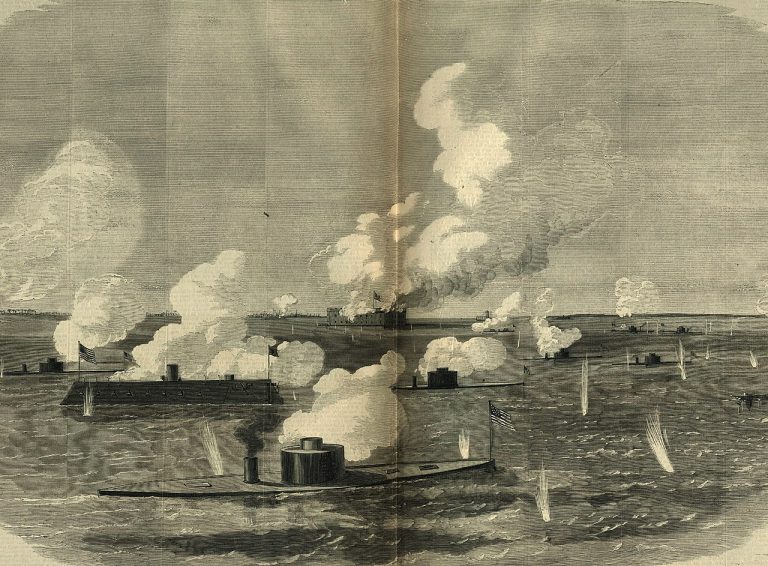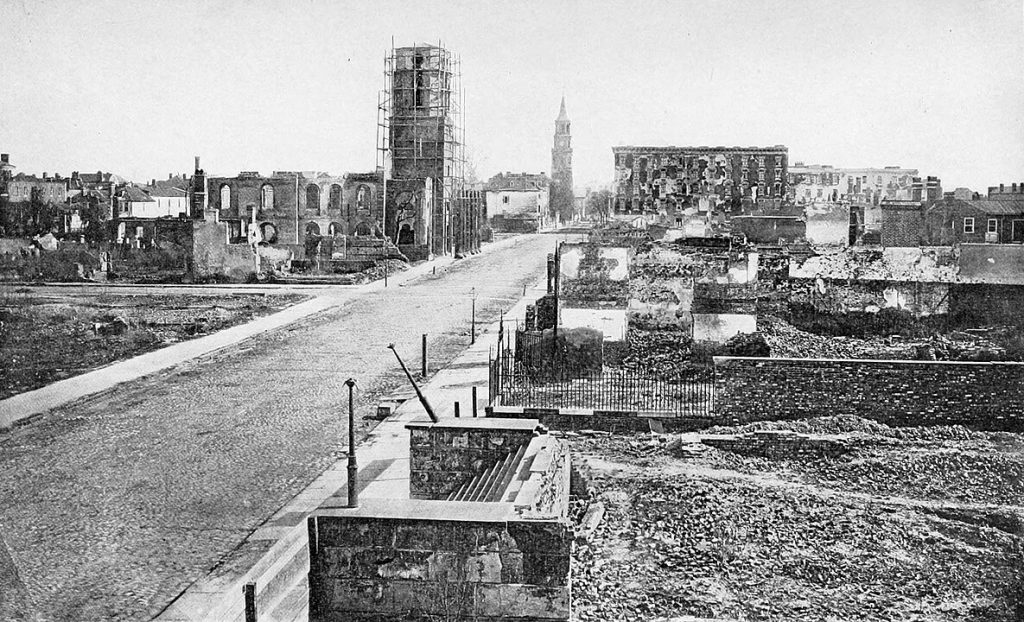
Image: Attack of the Federal Iron-Clads on Fort Sumter and the Rebel Batteries commanding the entrance to Charleston Harbor, on the 7th of April, 1863. Credit: U.S. Library of Congress.
Ironclad Ships Nantucket and Pontiac Captained by Stephen B. Luce Blockade,
Collapse Charleston and Savannah, Playing Critical Role Leading to Union Victory
Excerpted from Carroll Storrs Alden, Professor, Dept. of English, U. S. Naval Academy (Dec. 1924 Proceedings, Vol. 50/12/262)
Washington, D.C. The first year of the Civil War found Stephen Bleecker Luce a lieutenant, in charge of a gun division, on the steam frigate Wabash. She was the flagship of Captain DuPont in the battle of Port Royal, the best naval engagement of 1861. At the entrance to the deep inlet at this point (twenty-two miles from Savannah) the Confederates had erected two forts, and to crush them the Government had fitted out an imposing expedition of fifty ships, including the transports, with 13,000 troops. The odds were heavily in favor of the Union Fleet because it struck early before the land works were fully completed.

DuPont’s force had been scattered by a storm on the way south, and the means for disembarking the troops having been lost they were not ready to cooperate; but DuPont, realizing that each day of delay would enable the Confederates to strengthen their resistance, proceeded to attack the forts with the ships even before some of his number had arrived.
Dividing his fleet into two squadrons, he took the main squadron consisting of the nine heaviest ships led by the Wabash between the forts and into Port Royal Sound; the lighter vessels, designated as the “flanking squadron,” accompanied them to the farthest point within the sound and then remained behind to prevent the Confederate gunboat flotilla, issuing from a hiding place in one of the creeks, from delivering an attack as the main squadron turned.

DuPont’s plan was to bombard the forts as he slowly steamed past, and then making an ellipse again to return to the attack. The ships had laid their course near to Fort Walker on the southwest, and well-nigh smothering with their rapid fire the men who were serving the guns with scant or no protection, in a short time had silenced all the pieces. All that remained was to take possession of the works, and then proceed to do the same to Fort Beauregard on the northeast.
The Union losses were slight, but that was because of the strength of the fire delivered by their guns. Luce was in the thick of the fighting and was mentioned with commendation in the report of the commanding officer of the Wabash: “The three gun-deck divisions of IX-inch guns, under Lieutenants Upshur, Luce and Barnes, were commanded by those officers in a manner which illustrated the highest power, both of men and guns, and exhibited the greatest effect of manhood and training. I beg leave to commend these officers in terms of the warmest praise, both for skill and conduct…”
During more than three-fourths of the [Civil] War Luce was at sea, and for the larger part of this duty he was on this section of the coast, within easy distance of both Savannah and Charleston. Quickly acquiring an accurate knowledge of the waters, he was active in various reconnoitering expeditions. Later when promoted to lieutenant commander Luce commanded the ironclad Nantucket and the Pontiac. With these he joined in the blockade of Charleston and Savannah, with an occasional flash of excitement when a blockade runner attempted to slip past.
[end of excerpt]
The ironclad ships USS Nantucket and USS Pontiac played significant roles in the Union’s naval blockade and assaults on Confederate positions during the Civil War, particularly in the operations around Charleston and Savannah.
Charleston was a key port for the Confederacy, and the Union aimed to cut off supplies and reinforcements to the Southern states.
The Nantucket’s armored design allowed it to withstand heavy fire while engaging Confederate forts. The ship also played a part in the operations against Savannah, Georgia, supporting the Union’s strategy of isolating and capturing critical Confederate ports along the Atlantic coast.
The USS Pontiac was designed for shallow draft operations in rivers and coastal areas. These monitors were part of the Union’s strategy to maintain a tight blockade and support amphibious assaults. The Pontiac was essential in controlling the waterways and providing artillery support for ground troops.
Overall, the ironclad ships USS Nantucket and USS Pontiac were integral to the Union’s naval strategy, providing heavy firepower and resilience against Confederate fortifications, thereby aiding in the blockade and eventual capture of key Southern ports, leading to the surrender of Savannah under the command of Stephen Bleecker Luce.
The successful blockade of Charleston and Savannah, along with other Southern ports, played a crucial role in leading to a Union victory in the Civil War through several key mechanisms: Economic Strangulation, Isolation of Key Cities, Control of Supply Lines, and Psychological Impact (Lowered Confederate Morale, Booster Union Confidence).
The fall of Charleston in 1865 marked a major victory for the Union and a severe blow to Confederate morale and logistics.
As one of the Confederacy’s most important ports and a symbolic stronghold, Charleston’s blockade and eventual capture were significant. The fall of Charleston in 1865 marked a major victory for the Union and a severe blow to Confederate morale and logistics. Likewise, the capture of Savannah in December 1864 by General William T. Sherman, during his famous “March to the Sea,” was a crucial turning point. The fall of Savannah further disrupted the Confederate war effort and demonstrated the Union’s ability to penetrate deep into Southern territory.
Civil War: Ironclad Ships Captained by Luce Blockaded Charleston, Savannah (June 27, 2024)